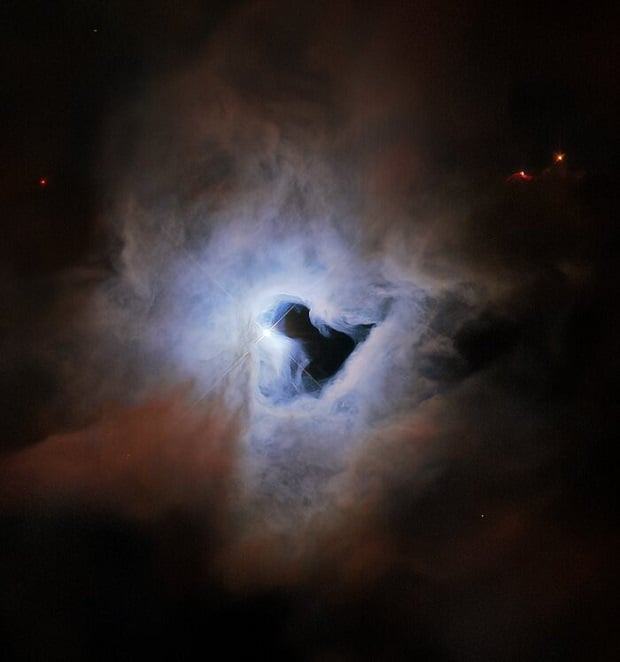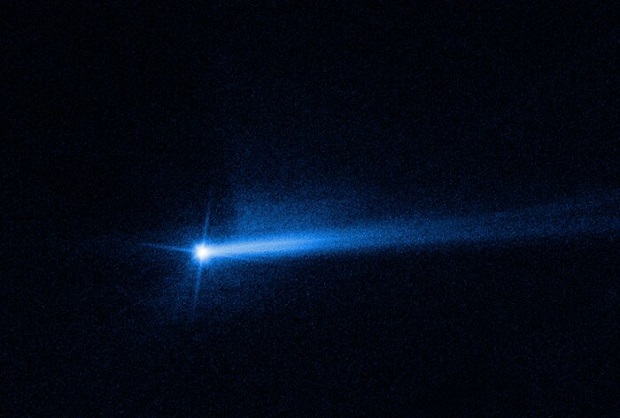
Nebula that appears after birth of star and double comet-like tail near Didymus-Dimorphos system: new Hubble photos
The Hubble telescope has taken some interesting new images showing a star-birth nebula as well as a double comet-like tail near the Didymus-Dimorphos system.
NGC 1999 is a reflection nebula in the constellation of Orion
This telescope photo shows NGC 1999, which is a reflecting nebula in the constellation of Orion. It is about 1,350 light-years from Earth and is close to the Orion Nebula, Earth's closest region of massive star formation.

NGC 1999 itself is also a relic of recent star formation: it is composed of detritus left over from the formation of a newborn star.
Reflecting nebulae like NGC 1999 can be compared to the fog around a street lamp: they shine only thanks to the light from an internal source. In the case of NGC 1999, this source is the aforementioned newborn star V380 Orionis, which can be seen in the center of this image. The most interesting feature of NGC 1999 is the hole that can be seen in its center and which resembles an ink-black keyhole of cosmic proportions.
In the past, astronomers believed that the dark spot in NGC 1999 was a Bok globule - a dense, cold cloud of gas, molecules and cosmic dust that obscures the background light. However, subsequent observations have shown that the dark spot is actually an empty region of space. Until now, the origin of this unexplained rift at the heart of NGC 1999 remains unknown.
A double comet-like tail near the Didymus-Dimorphos system
This Hubble photo shows the twin dust tails of the Didymus-Dimorphos asteroid system, formed after the NASA DART mission on Sept. 26, 2022.

The asteroid Dimorphos revolves around Didymos, and its rotation period before the DART probe impact was 11 hours and 55 minutes. On Sept. 26, the spacecraft crashed into Dimorphos, changing the asteroid's rotation time by 32 minutes to 11 hours and 23 minutes, although scientists originally thought it would change by about 73 seconds.
Hubble's observations showed how the asteroid's fragments that broke off after the impact behaved. The cloud of dust and debris over time has expanded and lost brightness, but the appearance of the tail (which occurred between Oct. 2 and Oct. 8, 2022) surprised experts, as is usually observed in comets and active asteroids.
- Related News
- The end of the Universe: 3 plausible theories of a global apocalypse
- Mutated bacteria resistant to drugs found on the ISS: What does this mean and why is it a problem?
- 4 flares erupted from Sun in rare event: the Earth may be hit by geomagnetic storm (video)
- 11 incredible satellite photos published on Earth Day
- NASA shows all of Ingenuity's flight trajectories in one video
- Could life exist on Saturn's moon Enceladus?
- Most read
month
week
day
- Meta unveils Llama 3 and claims it's the "most powerful" open source language model 872
- Once in a lifetime phenomenon: This year we will observe a star explosion that occurred 3,000 years ago 864
- WhatsApp to integrate AI function: What will it do? 809
- Google fires 28 employees who protested against company's cooperation with Israel 803
- iPhone 17 Plus will have smaller screen 737
- 5 best smartphones with IPS screens 733
- How often is it worth replacing a smartphone with a new one? 701
- How DNA analysis helps to solve crimes and who can sell your DNA data and why: Interview with former FBI scientist Bruce Budowle 687
- Huge battery, IP68/IP69K and MIL-STD-810H certifications: Ulefone will present the Armor Pad 3 Pro tablet (photo) 648
- Porsche unveils electric bike that costs more than $15,000: Why is it so expensive? 643
- Archive
